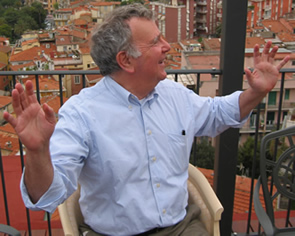Day 22: Florence

We find a parking space just outside of town and we walk to the hotel– the Albergo Pietrasanta–a very elegant and tasteful building located in the pedestrian center of town. We meet the director of marketing, Federica Lo Franco, who gives us a tour of the public rooms and some of the beautiful bedrooms and suites.
http://www.slh.com/files/HUPSAAP/Small_Header_main-image.jpg
We sit in the covered veranda looking out over the terrace

and discuss working together in the future.
It’s time for lunch when we leave and Federica recommends an informal trattoria just around the corner from the hotel. The Trattoria da Sci (Sci is local dialect for the name of the former owner) is one of those family places with no menu, a bottle of the house wine on the table and mama in the kitchen. We squeeze in through the door into a crowded dining room

and have a very delicious lunch while the rain continues to come down outside. We all have the gnocchi with a rich meat ragu to start and three of us have the roast pork with potatoes while I have stewed moscardini (baby squid) over excellent polenta. The wine is easy to drink and it is a very congenial lunch.
After lunch, we make a quick visit to the nearby village of Valdicastello….Maddie wants to check out the birthplace of Giosue Carducci, an Italian poet who won the Nobel Prize for literature in 1906. There is not much going on in Valdicastello on this very wet afternoon but we do find his house but unfortunately (but not unexpectedly) it is closed.

Maddie calls the telephone number listed on the gate but no one is available to come and open the house so we continue on our way.
When we drove into Pietrasanta, I had noticed signs for the village of Sant’Anna di Stazzema, which is the site of an infamous massacre of civilians and partisans by the SS during World War II as well as the location for Spike Lee’s latest movie, The Miracle of Sant’Anna. The movie is loosely based on the incident and tells the story of four black soldiers who are trapped in the village. So we begin to follow the signs for Sant’Anna which lead us high up into the mountains on a very narrow and twisting road. The rain continues and fog develops as we continue to climb.

The GPS and our maps are unclear about how far the village actually is so, as the fog gets worse, we decide to postpone our visit to another time.
We make one more stop before heading back to Florence…..at the very upscale beach resort of Forte di Marmi. It is not the best day or time of year to visit but we are surprised to find the stores–many of which are of the Gucci/Versace/Frette ilk–open for business.

We make a quick circuit of the town, stop for a coffee, buy the last umbrella from an African street vendor and get back on the autostrada.
We say goodby to Maddie and Patsy back in Poggio a Caiano and make our way back during the rush hour traffic and the rain.
For our late dinner, we stay close to home and go to da Mimmo right across the street from the apartment…..a large, very decorated restaurant enlivened by several large tables of English tour groups and later by a party for a recent Italian graduate. The restaurant has one of those large, pan-Italian menus but with a Calabrian accent. We both have pasta dishes…Diana’s has a spicy “nduja” sauce….followed by a dish of carpaccio for Diana and a plate of fried vegetables for me. The food is okay and a bit expensive for what we get. The service slows down considerably during the meal as the Italian group begins to arrive so we have to push to get the check.
But it has been a long day and we are glad that we only have to cross the street to get to the apartment.
I set my alarm for 1 am so I can get up and watch the election returns on the computer…..I stay up until the returns from California and the west coast put Obama over the top. We have a bit of a celebration at 5 am and then are happy to go to sleep.
Tomorrow we are off to Piemonte.













 s
s
























































































![Photo_101808_003[2].jpg](http://zurer.com/Italy2007WP/wp-photos/20081020-143020-6.jpg)
![Photo_101808_004[2].jpg](http://zurer.com/Italy2007WP/wp-photos/20081020-143020-1.jpg)
![Photo_101808_006[2].jpg](http://zurer.com/Italy2007WP/wp-photos/20081020-143020-4.jpg)
![Photo_101808_036[2].jpg](http://zurer.com/Italy2007WP/wp-photos/20081020-143020-3.jpg)
![Photo_101808_016[2].jpg](http://zurer.com/Italy2007WP/wp-photos/20081020-143021-12.jpg)
![Photo_101808_017[2].jpg](http://zurer.com/Italy2007WP/wp-photos/20081020-143020-2.jpg)
![Photo_101808_011[2].jpg](http://zurer.com/Italy2007WP/wp-photos/20081020-143020-5.jpg)
![Photo_101808_018[2].jpg](http://zurer.com/Italy2007WP/wp-photos/20081020-143020-8.jpg)
![nc1945_05 ciletti[2].jpg](http://zurer.com/Italy2007WP/wp-photos/20081020-143021-11.jpg)
![Photo_101808_031[2].jpg](http://zurer.com/Italy2007WP/wp-photos/20081020-143021-10.jpg)
![Photo_101808_032[2].jpg](http://zurer.com/Italy2007WP/wp-photos/20081020-143020-7.jpg)
![Photo_101808_025[2].jpg](http://zurer.com/Italy2007WP/wp-photos/20081020-143020-9.jpg)
![Photo_101708_001[9].jpg](http://zurer.com/Italy2007WP/wp-photos/20081020-141819-2.jpg)
![Photo_101708_005[9].jpg](http://zurer.com/Italy2007WP/wp-photos/20081020-141820-9.jpg)
![Photo_101708_004[9].jpg](http://zurer.com/Italy2007WP/wp-photos/20081020-141819-7.jpg)
![Photo_101708_008[9].jpg](http://zurer.com/Italy2007WP/wp-photos/20081020-141819-5.jpg)
![Photo_101708_011[9].jpg](http://zurer.com/Italy2007WP/wp-photos/20081020-141819-4.jpg)
![Photo_101708_017[9].jpg](http://zurer.com/Italy2007WP/wp-photos/20081020-141820-11.jpg)
![Photo_101708_018[9].jpg](http://zurer.com/Italy2007WP/wp-photos/20081020-141819-1.jpg)
![Photo_101708_020[9].jpg](http://zurer.com/Italy2007WP/wp-photos/20081020-141820-10.jpg)
![Photo_101708_022[9].jpg](http://zurer.com/Italy2007WP/wp-photos/20081020-141819-6.jpg)
![Photo_101708_023[9].jpg](http://zurer.com/Italy2007WP/wp-photos/20081020-141819-3.jpg)
![Photo_101708_024[9].jpg](http://zurer.com/Italy2007WP/wp-photos/20081020-141820-8.jpg)










 The search for the Torre Astura breaks down a few miles out of town when the tourist directional signs disappear….but we do finally reach the tower–a stubby brick building set in the water inside a tourist camping site.
The search for the Torre Astura breaks down a few miles out of town when the tourist directional signs disappear….but we do finally reach the tower–a stubby brick building set in the water inside a tourist camping site.













